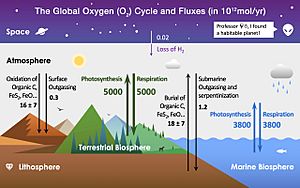Oxygen cycle facts for kids

The major fluxes between these reservoirs are shown in colored arrows. Green arrows show movement related to land plants and animals. Blue arrows show movement related to ocean life. Black arrows show movement related to the Earth's crust. The purple arrow shows oxygen moving into space.
We can learn about how much plants make food (photosynthesis) by looking at oxygen in the air.
The amount of carbon buried in the ocean floor helps us understand how much oxygen is used.
The oxygen cycle describes how oxygen moves around our planet. It travels through the atmosphere (the air we breathe), the biosphere (all living things like plants and animals), and the lithosphere (the Earth’s crust and rocks). This cycle shows how oxygen becomes available in these different places and how it gets used up.
The oxygen cycle is a special kind of biogeochemical cycle. This means it involves both living things (bio) and Earth processes (geo). Oxygen atoms change their forms as they move. They can be part of different molecules, like pure oxygen gas (O2), water (H2O), or carbon dioxide (CO2). These changes happen through chemical reactions.
Oxygen is one of the most common elements on Earth. Most of Earth's oxygen is actually found in rocks and minerals deep inside the Earth's crust and mantle. This makes up about 99.5% of all oxygen! The air, water, and living things hold less than 0.05% of the Earth's total oxygen. Besides oxygen gas (O2), oxygen atoms are also found in many other important molecules. These include water (H2O), carbon dioxide (CO2), and ozone (O3).
Contents
Oxygen in Earth's Layers
Oxygen is found in different amounts in each part of our planet.
The Atmosphere
The air around us is about 21% oxygen. This is a huge amount of oxygen gas (O2). The atmosphere also contains other molecules that have oxygen. These include ozone (O3), carbon dioxide (CO2), and water vapor (H2O). There are also small amounts of sulfur and nitrogen oxides.
The Biosphere
The biosphere includes all living things on Earth. About 22% of the biosphere is made of oxygen. Here, oxygen is mainly found as part of organic molecules. These are the building blocks of life, found in plants, animals, and all living cells. Oxygen is also a big part of the water found in living things.
The Hydrosphere
The hydrosphere is all the water on Earth. This includes oceans, lakes, rivers, and ice. About 33% of the hydrosphere is oxygen. Most of this oxygen is part of water molecules (H2O). There is also some free oxygen gas dissolved in the water, which fish and other aquatic animals breathe.
The Lithosphere
The lithosphere is the solid, outer part of Earth, including the crust and upper mantle. It holds the most oxygen, about 46.6%. In the lithosphere, oxygen is mostly found in silica minerals (like quartz) and other oxide minerals. These are the rocks and soils that make up our planet.
How Oxygen is Made and Used
Oxygen is constantly being produced and used up. Scientists call these "sources" (where oxygen comes from) and "sinks" (where oxygen is used).
Making Oxygen: Photosynthesis
The main way new oxygen is added to the atmosphere is through photosynthesis. This amazing process is done by plants on land and tiny phytoplankton in the oceans. During photosynthesis, these organisms use sunlight, carbon dioxide, and water to make their own food (sugars). As a byproduct, they release oxygen gas into the air.
For example, a tiny ocean bacterium called Prochlorococcus was found in 1986. It's so small, but it does half of all the photosynthesis in the open oceans! This means it produces a huge amount of the oxygen we breathe.
Making Oxygen: Photolysis
Another way oxygen is made is through a process called photolysis. This happens high up in the atmosphere. Strong ultraviolet light from the sun breaks apart water molecules (H2O) and nitrous oxide molecules (N2O). When these molecules break apart, they release oxygen gas (O2). The other parts, like hydrogen and nitrogen, often escape into space.
Using Oxygen: Respiration and Decay
The main way oxygen is removed from the atmosphere is through respiration and decay.
- Respiration: Almost all living things, including animals and humans, breathe in oxygen. They use this oxygen to break down food for energy. This process releases carbon dioxide back into the atmosphere.
- Decay: When plants and animals die, tiny living things like bacteria and fungi break them down. This process is called decay. These decomposers also use oxygen and release carbon dioxide.
Oxygen and the Ozone Layer
The presence of oxygen in our atmosphere led to the formation of the ozone layer. Ozone (O3) is a special form of oxygen. It's found high up in the stratosphere, a layer of Earth's atmosphere.
Here's how it forms:
- Sunlight breaks apart regular oxygen molecules (O2) into single oxygen atoms (O).
- These single oxygen atoms then join with other oxygen molecules (O2) to form ozone (O3).
The ozone layer is incredibly important for life on Earth. It acts like a natural sunscreen. It absorbs most of the harmful ultraviolet (UV) radiation from the sun. Without the ozone layer, too much UV radiation would reach the Earth's surface, which would be very dangerous for living things.
See also
 In Spanish: Ciclo del oxígeno para niños
In Spanish: Ciclo del oxígeno para niños
- Carbon cycle
- Nitrogen cycle
- Hydrogen Cycle

